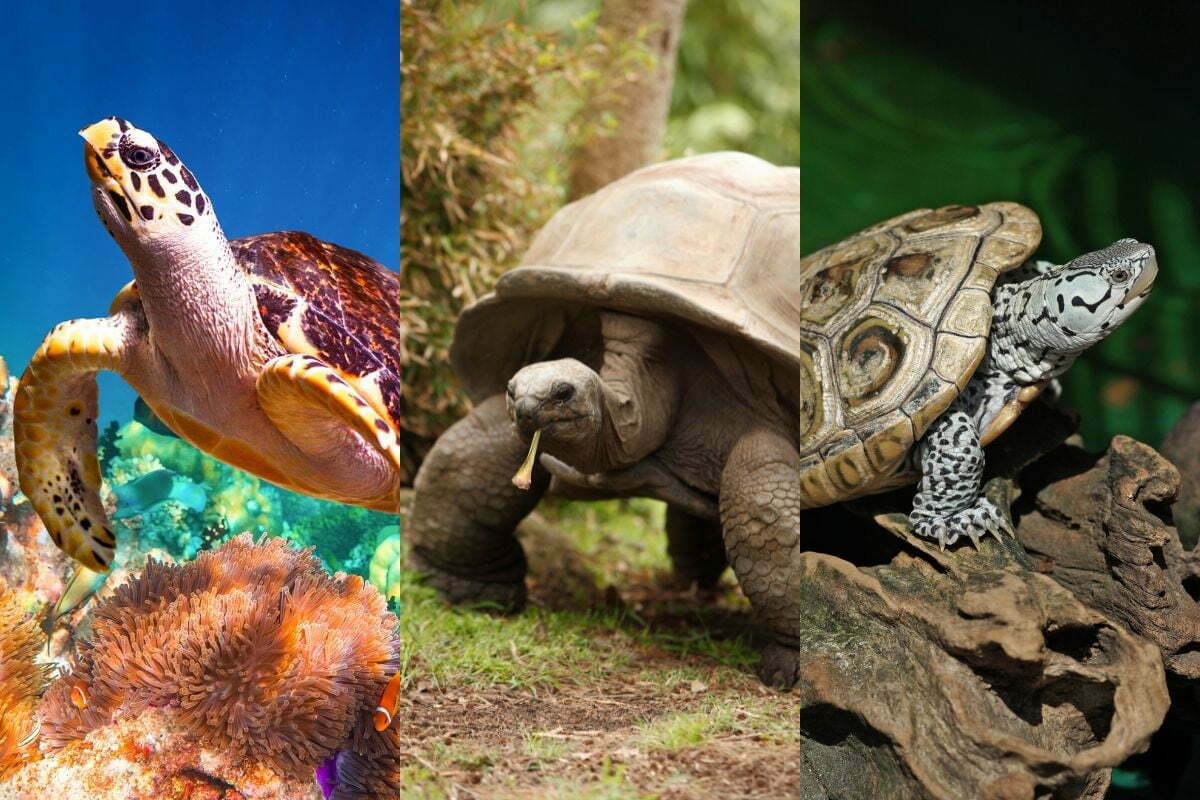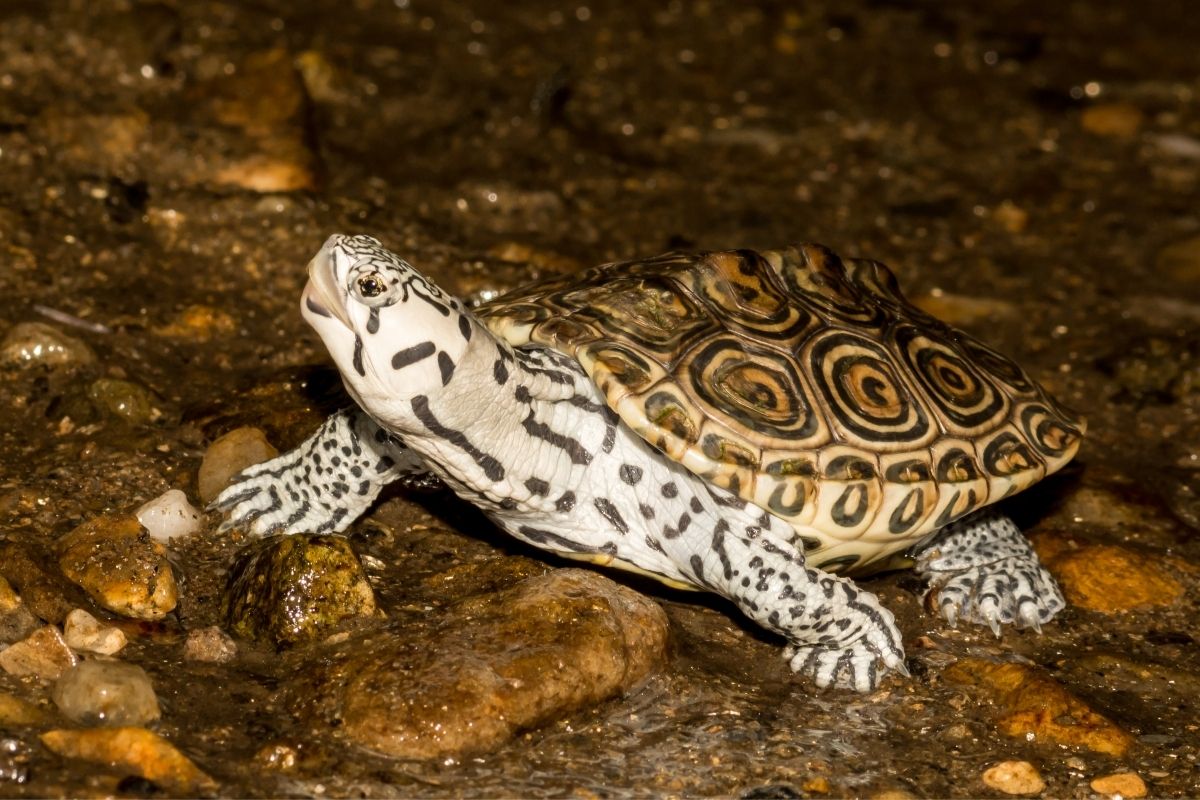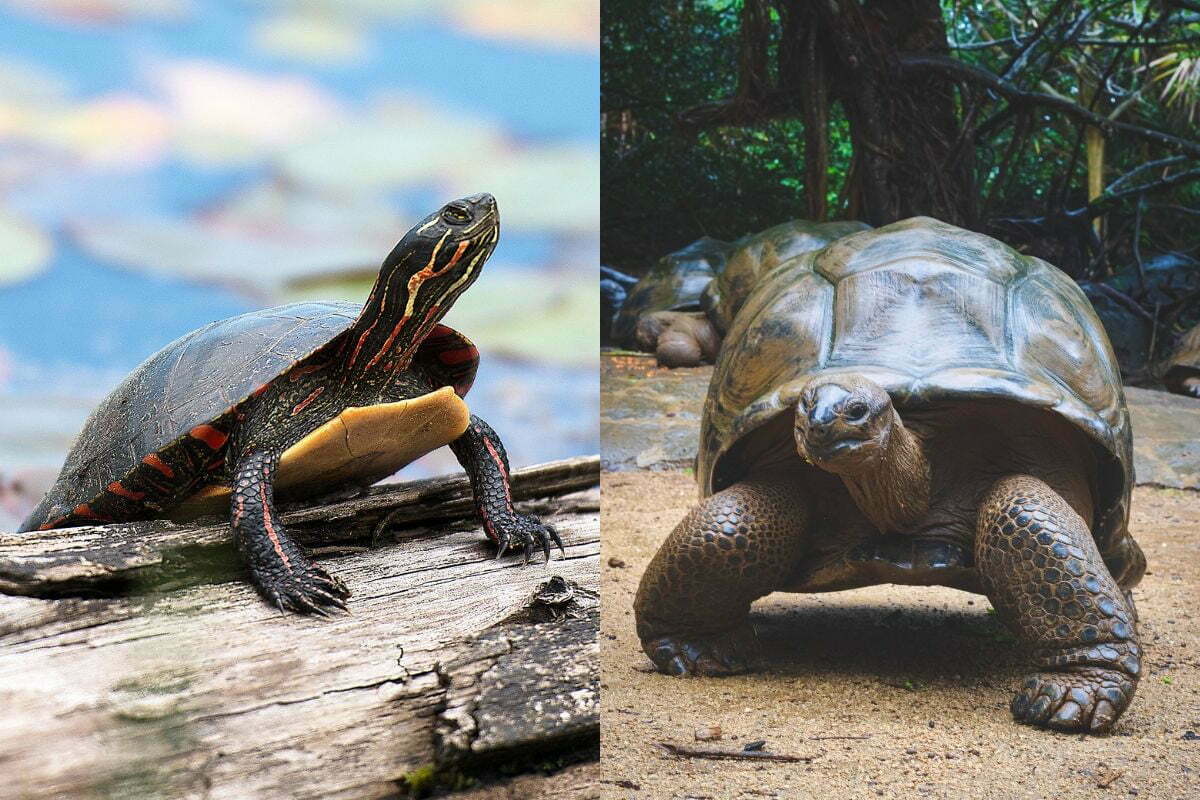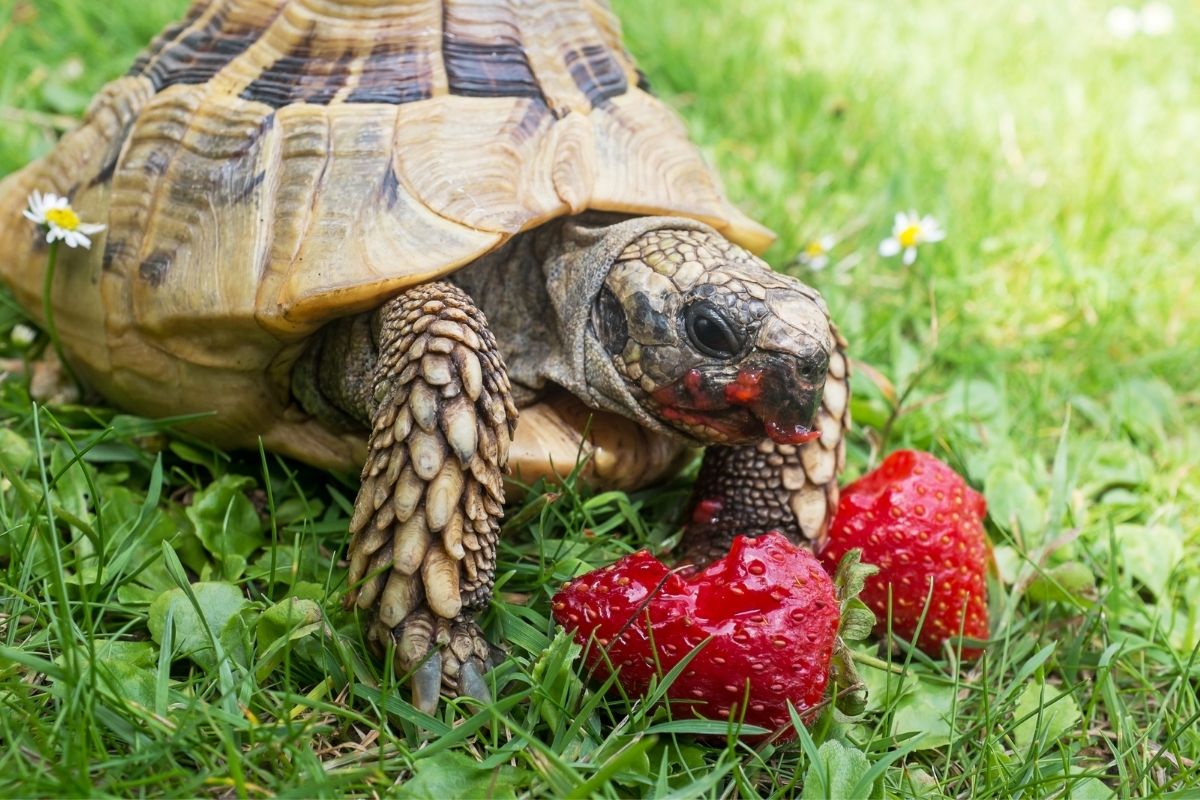For the most part, different reptiles are pretty easy to distinguish from one another. However, turtles, tortoises, and terrapins are the exception. They can easily look like one another and leave you confused.

If you are considering a turtle, tortoise, or terrapin as a pet, it is best to know how to distinguish between these three so that when you buy yourself a new friend, you know exactly what they are and what they need from you.
They are all members of the Chelonian family of reptiles, so they are actually all related, but this does not make them the same.
The primary difference between these three that is worth noting is their diets. You CANNOT mess this up! Tortoises are herbivores, and turtles are omnivores. Also, their habitat… Tortoises live on land, while turtles are water-based.
Terrapins, on the other hand, are small turtles that live in brackish waters.
So, how do you actually distinguish between these three creatures? Let’s get down to business and find out.
Is There An Actual Difference?
The most important thing you have to remember is that turtles, terrapins, and tortoises are related. So, it is not surprising that they are difficult to tell apart, and you should not feel silly for struggling to do so. They are actually very similar.
They are also all from the Chelonian reptile family.
Genetically this means they are all actually related. Although you can’t cross-breed them, their bodies work in very similar ways.
Furthermore, they are all cold-blooded, and this is something very important to be aware of. This means that it is totally possible for any of these three reptiles to freeze to death.
They may be fantastic pets, but they are not capable of making their own body heat and thus require heat to be provided by an external source.
All three of these animals also lay eggs. Only mammals give birth to live babies; turtles, terrapins, and tortoises will give birth to eggs.
You should not expect to get a lot of eggs from a turtle or tortoise, as they may only lay one egg per year or twice a year.
However, these eggs are edible, though it is not recommended to eat them, as you can get salmonella from tortoise eggs or turtle eggs.
Turtle eggs also present the risk of heavy metal poisoning upon ingestion as well.
All of these creatures also have a shell. In whatever way, each of these animals has a shell. Tortoises may have basic shells, making them look as though they are not completely formed.
However, they have evolved to be land-based, and thus they can move faster, but they do still have a shell.
In spite of all these similarities, these three very similar creatures do also have some major differences as well.
This is what we will have a look at.
We want to start with why terrapins are like turtles but not like tortoises, and then we will look at turtles and tortoises separately, as these two have more stark differences.
Terrapins: Unlike Tortoises, But Like Turtles

So, terrapins. Why are they like turtles? Well, because they are turtles. Terrapins are just a group of freshwater turtles. They live in lakes and streams instead of oceans and seas.
Although they can live in slightly salty brackish waters if required.
Terrapins are small for a turtle. You will actually be interested to know that there is no ‘official’ definition for a terrapin; some species are not even that closely related.
Let us not forget that the term ‘terrapin’ originated from a North American dialect during the colonial era in the U.S. This term was then brought to the U.K., ensuring it continued in the English Language.
Therefore, terrapins are basically just freshwater turtles.
So, for the purposes of discussing and acknowledging the differences between tortoises, turtles, and terrapins, the difference between terrapins and tortoises is the same as it is for turtles and tortoises.
Turtles VS Tortoises

We often lump turtles and tortoises in the same group. However, while they do share some similarities, they also share an equal number of differences too.
Both turtles and tortoises belong to the same family. The main differences between these two species are their size, habitat, and diet. Let’s take a look at their differences one by one.
Habitat
The absolute easiest way to distinguish between a turtle and a tortoise is where they live. It should not take very long to figure out which is which based on where they live.
You see, tortoises live on land; they are a descendant of turtles. Basically, they’re turtles who decided they liked land more and would vacate the water and make the land their permanent residence.
Nature is not into creating things that do not have a purpose, tortoises can’t swim, and they do not live in water at all. They will still bathe in the water, though. They actually take moisture into their body through a vent in their cloaca.
They will also drink water; however, if they get into deep water, they will drown.
There are tortoises all over our planet, able to live in forests, deserts, swamps, and so on. You can find them in Asia, Europe, Africa, and the Americas. However, there are none in Australia or Antarctica.
The box turtle in North America may mislead you into thinking it is a tortoise because it looks like it is one. However, it is not. It lived in ponds.
On the other hand, Turtles are actually semiaquatic or completely aquatic.
They will emerge to lay eggs. However, for the remainder of their lives, they will be in the water, swimming around. This actually makes them super easy to tell apart from tortoises.
Semi Aquatic species, such as the box turtle, will spend some time on land, and some in the water. They enjoy the best of both worlds.
It does make them easy to confuse with a tortoise, first of all. However, if you watch them for a long enough time, they will eventually go back to the water as they have to.
Box turtles are actually terrapins, thus making them the most confusing chelonian.
You will not find a turtle in the desert, not a living one anyway. They are absolutely reliant on water to be able to survive.
Turtles are more common in the U.S.A. than tortoises are, but they can also be from Europe and Africa as well.
Both tortoises and turtles are likely to hibernate (or brumate). They will do this the same way.
Digging a burrow and hiding out in the winter so that they can stay warm. This is one of the times it is hard to tell the difference between them.
You should never wake a wild chelonian when it is hibernating. Doing this can result in the death of the animal, so the best thing that you can do if you are truly eager to know whether it is a turtle or tortoise is to return once it is out of hibernation.
Remember, if it is swimming, it is a turtle. If not, it is probably a tortoise.
Diet

If you own one of these as a pet, and you are not entirely sure if you own one of these as a pet, and you are not certain if it is a turtle or a tortoise, then do not worry.
Even if their habitat has you confused, there is another way you can tell which is which.
Remember, however, that this is not so simple. Some turtles can be very confusing in how they eat.
Tortoises are herbivores, meaning they eat plants. In the wild they will eat whatever plants are around them, being careful to avoid any plants that are potentially toxic. This means that their diet can be quite varied.
Tortoises that are found in the desert may be found snacking on a cactus. On the other hand, tortoises found in forested areas could include berries in their diet.
However, not all tortoises are wild are they, and you may find that your pet tortoise is a little more spoiled, something we are often guilty of too.
They might be a bit fussier about what they want to eat. This may actually result in them not eating all of the nutrients that they actually require. Again, we are also at fault for this.
Yet, for domestic tortoises, you can supplement their diet with supplements such as calcium supplement or D3, should you think they are not getting enough sunlight or UVB.
Alternatively, turtles are omnivorous, meaning they are like us (mostly) in that their diet is made up of plant life and animal life.
However, this is a tricky thing to say. Technically, MOST turtles are omnivorous. Yet there are some turtles that are not.
Soft-shell turtles, for example, can be totally carnivorous, and if you see them eating a plant, then there is something not right with them.
Some turtle species are totally herbivorous. And eating animal life is an indicator that something is wrong.
So, there are differences between different turtle species, but for the most part, if you see a wild chelonian chowing down on an insect, snail, fish, crab, or other living things, you can be certain that it is a turtle.
Tortoises just do not indulge in a diet of living things, and this is basically because their diets are required biologically to be a low protein diet, so they simply do not need this; in fact, they could actually become really sick if they did eat living creatures!
Just remember that it is also common to see turtles eating plant life as well, although you won’t see one eating a cactus, as turtles do not live in environments where they could find one.
So, remember that observing a chelonian for their diet will not always 100% confirm what an animal is; it will only tell you if it is definitely a turtle if it is eating ‘meat.’
It is not an infallible way of telling what the creature is, but it is a good indicator, helping you break down your options.
Longevity
Fortunately, or unfortunately, depending on your view, testing an animal’s longevity to see if it is a turtle or tortoise is not something you will be able to do very often, as these animals are very long-living animals.
For tortoises, their lifespan can be very, very long indeed/
In fact, it is entirely possible that we won’t even live long enough to carry out this type of test more than just one time!
Let’s break down their life spans.
- Freshwater turtles have the shortest life span. They only live an average of 2 to 4 decades (20-40 years)
- Sea turtles can live longer, but this is under the assumption that they do not fall prey to another animal or fall sick. Otherwise, they can live for 6 to 7 decades (60-70 years).
- Tortoises can usually live for about 6 to 8 decades (60-80 years). Therefore, if you get a pet tortoise, there is a chance it will outlive you.
- Let us not forget the giant tortoise, which is known for being able to live up to an amazing 150 years! A pet giant tortoise can live through many generations of a family.
This is important to know, not just for identification but also for pet owners. Should you take on a chelonian as a pet in your home, you will need to be aware that they are a commitment for a lifetime.
They will still be going strong long after another pet, such as a cat, dog, and certainly hamster, will have moved on.
You should also consider what you should do with your pet if you are incapable of being able to take care of it when you get older, this is totally probable, and you may find that once you have passed on your pet will keep on living!
Physical Traits

It is not surprising that tortoises and turtles also look different. Given how they are actually two totally separate species at different stages in their evolutions.
Their bodies are actually marked with stark differences between the two, and they have started differentiating themselves based on their habitats and how they live.
There are four primary parts of their bodies that have changed to reflect these differences when observed by the naked eye. These are their shells, feet, necks, and tails.
We will now take a look at each of these body parts and the differences they have, as well as why.
So, let’s start with the one we know you are dying to know about… shells.
Shells
One of the most distinctive features of chelonians is their shell. There are some pretty distinct differences found in the shells of tortoises and turtles.
Starting with tortoises their shells are for defense. They’re terrestrial creatures, and so if they’re attacked by a predator, they cannot easily flee, swimming away like turtles can.
This means that their shells have actually evolved to become a constantly present shield. Enabling them to fend off their attackers and predators without even having to move.
Their shells have grown to be tall, round, and they are also much heavier. This is something you may notice if you were to pick up a tortoise versus picking up a turtle.
The added weight of their shell does make them slower moving than a vast majority of turtles which can almost run.
However, it does not matter that they are slower. If they are attacked, they will be able to withdraw as much as they possibly can into their shell.
What about the biology of their shells?
Well, their shells are in two particular parts, the plastron, which is the bit at the bottom, and the carapace, which is the bit on the top of the tortoise. They are joined but actually evolved separately.
In their shell, a tortoise actually has a stunning 50 bones! The external layer of a tortoise shell is made up of scutes; these are plates made out of keratin, which is the same substance our hair and nails are made from.
A tortoise does not shed its scutes, and this means that they are in need of protection from damage whenever and wherever they can!
Alternatively, turtle shells are much different. While a tortoise’s shell is very good for hiding on land, if they were to go underwater, they would be a huge failure.
A huge shell like this would actually create massive drag, and the turtle would hardly be able to swim.
This means turtle shells are actually lighter and flatter. It enables them to cut through the water with ease and gives them that extra mobility in the water.
Yet, this does come with a downfall; they are not able to withdraw into their shell like tortoises can.
Freshwater turtles are even more different. They do not need to swim at high speeds, so their shells are like a part house, part typical turtle shell.
Box turtles are actually more similar to tortoise shells, as they use their shells as houses more than for speed.
Some turtles will also have scutes, but not all. Turtles with soft shells have a layer of skin where scutes would be. Their shell will feel like leather, allowing them to swim with even greater speed. However, this lacks any true defense.
Should a turtle shell have scutes, these will often shed, allowing the turtle to grow and also allowing for them to be replaced, as scutes underwater are prone to infections and such.
Feet
What is the best way to tell if you’re dealing with a tortoise or turtle? Well, look at their feet, of course!
Tortoises live on land, and turtles primarily live in water. So, their feet have very different uses. Even if you are brand new to chelonians, it will be easy to tell which is which when you give one of these guys a foot inspection.
Tortoise feet are designed for land. They have knees allowing them to bend as they walk. Their feet touch the ground on their toes, and their legs are fairly short, making them able to retract into the shell when danger is…a-foot.
Box turtles are an exception; they do have the same feet as a tortoise, so expect confusion with these guys. However, they do have one distinct feature to tell them apart.
While tortoise feet do not entirely touch the ground, only their toes, turtle, and even box turtle feet completely touch the ground on land.
However, sea turtles have flippers instead of feet, just like how dolphins or seals have flippers. They are a very distinct way to tell that a creature is a turtle.
Obviously, this makes them awful at walking on land and is part of the reason that they only surface to lay eggs. However, they are very good swimmers and can swim at great speeds.
Necks
Sadly, the necks of these creatures do not offer a lot of ways to tell the difference. But it does still offer tips.
Both turtles and tortoises can retract their necks into their shells, although some turtles cannot. Yet, there are some turtles called ‘sidenecks’ that can move their necks into their shells in a sideways motion. Tortoises do not do this, and most turtles do not, either.
This means that you should be able to identify a side-neck turtle as a turtle due to this motion. However, there is very little else that will help you.
Tails
Chelonians have tails, which means both turtles and tortoises will have tails, so there is just no way to tell the difference between the two using their tails.
However, you can typically tell the difference between their genders via the length and the width of a tail.
Female chelonians have short and thin tails, whereas males usually have thicker and longer tails. This is pretty standard across the whole chelonian species.
Frequently Asked Questions
Which Is Bigger, A Turtle Or Tortoise?
Turtles are actually generally larger than tortoises. The largest turtle is the ‘leatherback turtle’. They can be 1.8-2.2 meters long and can weigh 250-700 kg.
Which Is A Better Pet, Turtle Or Tortoise?
Both are great pets, although both can outlive you. However, tortoises are a bit more low-maintenance than turtles. However, be cautious of their size; the larger they are, the more space they will need.
Is A Red-Eared Slider A Terrapin?
Red Eared Sliders are popular pets, they are much like European Pond Turtles, and they are a small terrapin species.
Do Turtles Recognize You?
Yes, if you have a pet turtle, it will be able to recognize you and tell you apart from other humans.
To Conclude
Hopefully, you will now be able to tell the difference between a turtle, a tortoise, and a terrapin. Remember, the most notable ways you can tell is through their feet, shells, diets, and habitats.
These are wonderful animals, but if you have one as a pet, remember they may likely outlive you!
